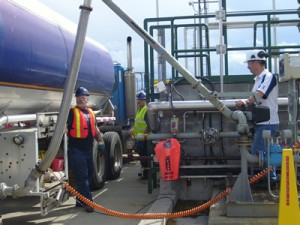
There are far too many subsidized ethanol plants to meet too little demand for the gasoline additive.
The United States Environmental Protection agency this morning requested public comments on a waiver application to increase the amount of ethanol that can be blended into a gallon of gasoline to up to 15% of volume (E15). At the heart of this seemingly innocent request is a push by taxpayer-subsidized fat cats in the agricultural sector to have you pay more for a gallon of fuel even as demand declines and fuel efficiency increases.
Since 1978, the limit has been 10% ethanol (E10) for conventional (non flex-fuel) vehicles for sound technical reasons – ethanol picks up water and corrodes the fuel systems of the vast majority of vehicles on the road today. It also has less energy density per gallon than gasoline, which means that ethanol fuels provide fewer miles per gallon when you use a fuel with it, adding increased driving cost to the insult of taxpayer subsidies.
The request for the waiver to increase the percentage of ethanol in the fuel you buy comes from 54 ethanol manufacturers who are struggling to remain in business since the price of oil has dropped. Now even the taxpayer subsidized cost of ethanol is no longer competitive on the market. Today regular gasoline is averaging $2.05 a gallon, down from $3.40/gallon a year ago, according to AAA.
In the face of a decline in gasoline usage in the U.S., where even ExxonMobil says demand is probably at or near its peak, there are far too many ethanol plants to meet too little demand for the gasoline additive.
You are already subsidizing ethanol at 45 cents per gallon by way of a tax credit to companies that blend ethanol with gasoline, as well as a requirement that ethanol be blended into gasoline. As a result, U.S. consumption of ethanol last year exceeded 9 billion gallons — a record high, according to the Congressional Budget Office. That credit is costing U.S. taxpayers revenue losses of between $3 and $4 billion a year.
This production subsidy for ethanol applies to both domestic and imported ethanol, but the United States charges importers of ethanol a tariff of 54 cents per gallon and an ad valorem tariff of 2.5% of the value of the imported ethanol, which means countries such as Brazil that can produce ethanol much more efficiently than the U.S. are blocked from selling it here. (Prices for ethanol sold in the United States fluctuated between $1.61 and $2.90 per gallon in 2008.)
It was the business-interest subservient Bush Administration that put the subsidies in place by way of the Energy Independence and Security Act of 2007, and mandated that the required usage of biofuels in the United States be at least 20.5 billion gallons annually by 2015, or more than double the country’s usage in 2008. This from an administration that professed to “let the free market sort things out” while its leader Bush — aka “I’m the decider” — was doing exactly the opposite.
Under current demand, Bush’s mandated ethanol use isn’t going to happen. An estimated 2 billion gallons of ethanol production capacity was idled in early 2009 in response to economic pressures. So now the industry is lobbying the Obama Administration to mandate that more ethanol be blended with gasoline.
What’s needed here is a rational, long-term energy policy and not short term subsidies for special interest groups. This will be another tough one for the administration to act on rationally since the agricultural lobby is powerful, and there are taxpayer subsidized ethanol blending plants it 26 states.
